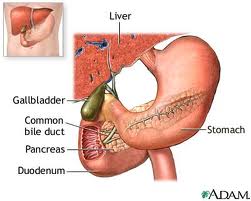|
Endoscopic retrograde
cholangiopancreatography (ERCP):
Endoscopic
retrograde cholangiopancreatography (ERCP) is a
technique that combines the use of endoscopy and
fluoroscopy to diagnose and treat certain
problems of the biliary or pancreatic ductal
systems. Through the endoscope, the physician
can see the inside of the stomach and duodenum,
and inject dyes into the ducts in the biliary
tree and pancreas so they can be seen on x-rays.
ERCP is used primarily to diagnose and treat
conditions of the bile ducts, including
gallstones, inflammatory strictures (scars),
leaks (from trauma and surgery), and cancer.
The patient
is sedated or anaesthetized. Then a flexible
camera (endoscope) is inserted through the
mouth, down the esophagus, into the stomach,
through the pylorus into the duodenum where the
ampulla of Vater (the opening of the common bile
duct and pancreatic duct) exists. The sphincter
of Oddi is a muscular valve that controls the
opening of the ampulla. The region can be
directly visualized with the endoscopic camera
while various procedures are performed. A
plastic catheter or cannula is inserted through
the ampulla, and radiocontrast is injected into
the bile ducts, and/or, pancreatic duct.
Fluoroscopy is used to look for blockages, or
other lesions such as stones.
When needed, the opening of the ampulla can be
enlarged with an electrified wire (sphincterotome)
and access into the bile duct obtained so that
gallstones may be removed or other therapy
performed.
Other procedures associated with ERCP include
the trawling of the common bile duct with a
basket or balloon to remove gallstones and the
insertion of a plastic stent to assist the
drainage of bile. Also, the pancreatic duct can
be cannulated and stents be inserted. The
pancreatic duct requires visualisation in cases
of pancreatitis.
In specific cases, a second camera can be
inserted through the channel of the first
endoscope. This is termed duodenoscope-assisted
cholangiopancreatoscopy (DACP) or
mother-daughter ERCP. The daughter scope can be
used to administer direct electrohydraulic
lithotripsy to break up stones, or to help in
diagnosis by directly visualizing the duct (as
opposed to obtaining X-ray images). |